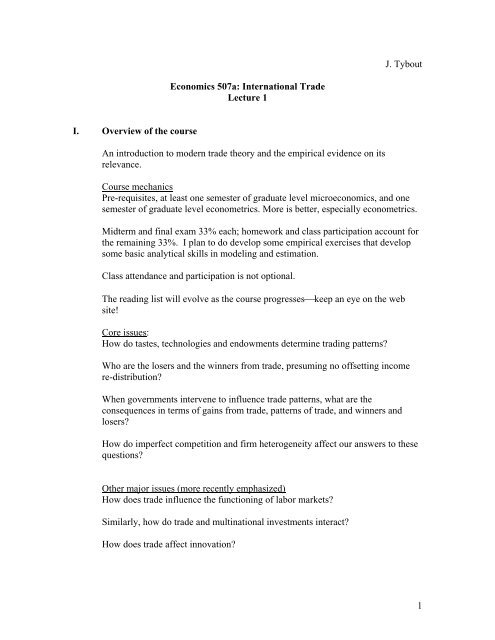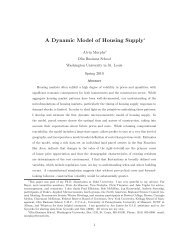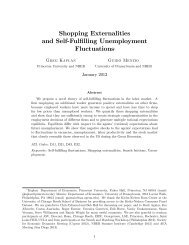1 J. Tybout Economics 507a: International Trade Lecture 1 I ...
1 J. Tybout Economics 507a: International Trade Lecture 1 I ...
1 J. Tybout Economics 507a: International Trade Lecture 1 I ...
- No tags were found...
You also want an ePaper? Increase the reach of your titles
YUMPU automatically turns print PDFs into web optimized ePapers that Google loves.
J. <strong>Tybout</strong><strong>Economics</strong> <strong>507a</strong>: <strong>International</strong> <strong>Trade</strong><strong>Lecture</strong> 1I. Overview of the courseAn introduction to modern trade theory and the empirical evidence on itsrelevance.Course mechanicsPre-requisites, at least one semester of graduate level microeconomics, and onesemester of graduate level econometrics. More is better, especially econometrics.Midterm and final exam 33% each; homework and class participation account forthe remaining 33%. I plan to do develop some empirical exercises that developsome basic analytical skills in modeling and estimation.Class attendance and participation is not optional.The reading list will evolve as the course progresses⎯keep an eye on the website!Core issues:How do tastes, technologies and endowments determine trading patterns?Who are the losers and the winners from trade, presuming no offsetting incomere-distribution?When governments intervene to influence trade patterns, what are theconsequences in terms of gains from trade, patterns of trade, and winners andlosers?How do imperfect competition and firm heterogeneity affect our answers to thesequestions?Other major issues (more recently emphasized)How does trade influence the functioning of labor markets?Similarly, how do trade and multinational investments interact?How does trade affect innovation?1
There is far more on the reading list that one can reasonably hope to master over a 12-week period. I will indicate which papers to study closely, and which are there to indicatewhat you might read if you wanted to pursue the topic further. Also, I do not expect tocover all of the sections of the reading list this fall. As we get further into the material, wewill take up the question of whether to study multinationals or innovation.Brief tour of the reading listSection 1: It is not possible to follow the recent literature without first laying a foundationof basic theory. We therefore begin with the traditional neoclassical trade model, whichpresumes that cross-country differences in factor endowments are the fundamental reasonfor trade. Some fundamental results emerge from these models that still underpin modeltheoretical and empirical work.After developing the theory, we briefly consider the empirical literature on the power ofthese models to explain trade flows.Section 2: The models considered in section 1 presume that factors and productiontechnologies are homogeneous across countries. In section 2 we study an alternative typeof trade model in which cross-country differences in factor abundance are replaced bycross-country differences in sector-specific productivity levels. The basic idea behind thismodel was developed by David Ricardo in 1817. It was eclipsed by the neoclassicalmodel of section 1, partly because the model offers no systematic explanation for whycertain countries are good at producing certain things, and differences in factor stocksseemed to be a good explanation. But the model has made a strong comeback in the past25 years, perhaps because empirically, factor endowments seem to leave a lot of tradeunexplained. It underpins some of the most important recent contributions. We will studythe two seminal papers in relative detail—Dornbusch et al, and Eaton and Kortum.In section 3, we first generalize the basic neoclassical trade model by introducing productdifferentiation and scale economies. Drawing on the seminal work by Krugman andHelpman we develop several new results: trade allows countries to specialize in theproduction of certain product varieties, and thereby facilitates scale economyexploitation. It also leads to a larger global menu of available varieties, which is good forvariety-loving consumers and (when intermediate inputs are differentiated) for productiveefficiency.Early models of imperfect competition treated all producers as using the sametechnology. A new generation of models has emerged that treats producers asheterogeneous—some are more efficient than others and/or produce more appealingproducts. These models are variants on Marc Melitz’s seminal paper, which we will studyrelatively closely. A variant of the Eaton/Kortum model that incorporates plantheterogeneity and imperfect competition will also receive some attention.At this point we are equipped to analyze the effects of trade on the characteristics ofindustrial sectors. (Dispersion in technical efficiency, pricing behavior, scale economy2
exploitation, mix of products produced.) We take stock of the empirical evidenceconcerning these possible effects of tradeThe remainder of the course concerns areas that are currently “hot” .Section 4 treats models that bring labor markets into trade models in a more serious waythan the canonical formulations in sections 1-3. Standard models do a poor job ofpredicting the effects of trade policy on wage inequality/unemployment, both becausethey treat all workers as homogeneous, and because they do not allow for labor marketfrictions. We’ll look at some attempts to do better.Section 5 focuses on a related issue: global fragmentation of production. Reductions incommunication costs, reductions in trade costs, and increased participation in the globaleconomy by countries that were on the fringes have led to a surge in FDI and trade inintermediates. This section treats some of the recent efforts to model and measure thesephenomena.Section 6 concerns the possible effects of trade on innovation and growth. <strong>Trade</strong> changesthe returns to investment in new technologies and can act as a conduit for existingtechnologies embodied in intermediate or capital goods. This part of the course presentssampling of theories that build on the canonical models from the beginning of the course,then turns to empirical evidence on their relevance.II.The simple mechanics of the 2 x 2 Hecksher-Ohlin modelA. PreliminariesAssumptions• perfect competition• infinite number of profit maximizing firms• the same production technologies are available in all countries• two primary factors (L, K)• constant returns to scale,X j = F j ( L j , K j ) = L j f ( k j ) ,f '() > 0 , f ''() < 0j k jj k j• two final goods, agricultural and industrial, indexed by j 0 {1, 2}• homothetic, identical tastes throughout the world; both goods are consumedeverywhere.• no factor intensity reversals3
Define:⎡aL1aL2⎤A = ⎢ ⎥ = matrix of input requirements per unit output. (Note that these⎣aK1aK2 ⎦depend only upon k j in each sector.)Factor market clearing condition:L = aL 1X1+ aL2X 2 and K = aK 1X1+ aK2 X 2 ,Competitive output pricing:P = a w a r and P = a w a r .1 L1+ K12 L2+ K 2Profit maximization:Competitive firms maximize profits by setting the price of each input equal to thevalue of its marginal product. Thus:w PjMPLjf j ( k j ) − k j f j '(k j )= =. The numerator is a monotonic positiver PjMPKjf j '(k j )function of k and the denominator is a monotonic negative function of k, given aconcave production technology ( f j ''(k j ) < 0.) Thus the wage-rental ratiouniquely determines the profit-maximizing capital-labor ratio in each sector,aKjk j = , and the factor requirements per unit output:aLjL j 1K j 1a Lj = = ; akj= = , thereby fixing theL j f ( k j ) f ( k j ) L j f ( k j ) k j f ( k j )minimum costs of producing a unit of output: C = a w a rB. The Factor Price Equalization Theoremj Lj +The claim:When a set of countries faces common global prices, and each countryproduces both goods, identical factor prices will prevail in all countries.Kj4
Geometric proofUnder the assumption of no factor intensity reversals, one good is always moreintensive in a particular factor (relative to the other good), regardless of factorprices. Let’s assume that good 1 is relatively labor intensive, by which we meanaL1aL2> .a aK1K 21rKP Q $1 country’s endowment ratio2 2 =• P Q $ 11 1 =•• Aan endowment outside the cone1LwWorld prices dictate the position of these unit revenue isoquants, and theassociated, unique wage-rental ratio that is consistent with zero profits in bothsectors. In turn, this factor price ratio implies factor proportions in each sector, asrepresented by the heavy rays from the origin.A caveat: If the country only produces one of the goods, its factor prices are notdetermined by international trade alone. When will it produce only one good?When its factor endowments lie outside the “cone of diversification” defined bythe heavy arrows. (Refer to the lower dotted arrow).Suppose that the country’s capital intensity is given by the lower dotted ray. Thenat the factor prices implied by global product prices, there is excess demand forcapital. To see why, note that the country’s factor endowment must be a convexcombination of the cone borders if it is to produce both goods:KL⎛= ⎜⎝L1⎞⎛K⎟⎜L ⎠⎝L11⎞ ⎛+ L2⎟ ⎜⎠ ⎝ L⎞⎛K⎟⎜⎠⎝LAt an endowment like the lower dotted vector, excess demand for capital at thefactor price ratio shown will drive up the relative price of capital until productionat point A is cheap enough to eliminate losses (refer to the factor price ratioassociated with the short dotted line).22⎞⎟⎠5
As an aside, note that this diagram shows why factor intensity reversals must beruled out to get factor price equalization. Consider:Kgood 1’s isoquantgood 2’s isoquantLAt low w/r, good 1 is capital intensive, but at high w/r, it is labor intensive. Thesame global prices are consistent with two different sets of capital intensities.Perhaps this helps to explain the fact that wages are lower in the South than in thenorth, although both regions produce a pretty large range of goods. (Other thingsmatter too, especially productivity.)Factor price equalization can also be established using unit cost frontiers. Eachcurve shows the combinations of the wage rate and the rental rate that imply aunit cost of production equal to the output price of the sector in question.rgood 2good 1B ••• Aw• Given our assumption that good 1 is labor intensive, changes in the wagerate always have a relatively large effect on good 1’s cost, and must becompensated with relatively large changes in r. That is, the unit costcurve for good 1 is relatively steep. More formally, the first-order6
increase in their real purchasing power. The opposite result holds for theowners of the other factor.Previous diagrams suffice to establish that an increase in the price of good 1 raiseswages and reduces the price of capital, holding the price of good 2 constant.In terms of growth rates,Pˆ1= wˆθ ˆ ˆ ˆL1+ rθK1+ aL1θL1+ aK1PˆθK12 = wˆθ L2+ rˆθ K 2 + aˆL2θL2+ aˆK 2where θijare the share of factor i in total earnings of good j. These equationssimplify because of an Envelope theorem: although the a’s adjust to factor pricechanges, the first-order effects of these adjustments on costs are zero because theyare starting from their optimal values.θK 2Each firm takes factor prices as given and adjusts its factor proportions (a’s) tominimize cost per unit output. From the first-order conditions, at any costw FL− daKminimizing point on an isoquant: = = , where the secondr FKdaQ=1Linequality follows from, dQ = 0 = F da + F da . Hence⎛ da⎜⎝ aKK⎞⎟ra⎠K⎛ da+⎜⎝ aLL⎞⎟wa⎠lL= 0 , or aˆ θ aˆθ = 0 .LjLKLj+Kj KjKSubstituting aˆ θ aˆθ = 0 into the price growth equations above yieldsLjLj+Kj KjPˆ1 = wˆθ L1+ rˆθ K1and Pˆ2 = wˆθ L2+ rˆθ K 2 , which implies that the commodity pricechanges are convex combinations of the factor price changes. Further, if the twocommodity prices move in different directions, the one that increases must movemore at a larger rate than the associated price.⎛ Pˆ⎞ ⎡θ⎜ 1 L⎟= ⎢⎝ Pˆ2 ⎠ ⎣θL12θθK1K 2⎤⎛wˆ⎞⎥⎜⎟ , so solving for factor price growth, we have:⎦⎝rˆ⎠⎛ wˆ⎞ ⎡ θ K 2⎜ ⎟ = ⎢⎝ rˆ⎠ ⎣−θL2−θθK1L1⎤⎥D⎦−1⎛ Pˆ⎞⎜ 1 ⎟, where D = θ L1θK 2 −θL2θK1>0 by ourˆ⎝ P2⎠assumption that good 1 is labor intensive. Setting Pˆ2 = 0 to normalize, the effectof an increase in P 1 on wages is positive and the effect on the return to capital is8
negative. Further the coefficientθ ’s lie between zero and one.θ K2D−1must be greater than unity because allImplication: if opening to trade drives down the price of the good that usesintensively the factor you supply, you stand to lose. (Lobbying groups should lineup according to factor rather than industry.)Remember for future discussions that both the factor price equalization theoremand the Stolper-Samuelson theorem depend heavily on some special assumptions.D. The Rybcznski TheoremRybcznski theorem(A dual to the Stolper-Samuelson theorem.) Expanding one factor stock whileholding output prices constant leads to a more than proportionate expansion inthe good that uses that factor intensively, and a contraction in the other good.Log-differentiating the factor market clearing conditions, we have:Lˆ= aˆL1λ + aˆλ + λ Xˆ+ λL1L2L2L11L2Xˆ2Kˆ= aˆK1λ + aˆλ + λ Xˆ+ λK1K 2K 2K11K 2Xˆ2Further, if we assume that the conditions for factor price equalization hold, factorintensities are pinned down by global prices:Lˆ= λ Xˆ+ λL11L2Xˆ2Kˆ= λ Xˆ+ λK11K 2Xˆ2Where ij λ the fraction of factor i allocated to good j. The logic is simple. Supposethe labor force expands, while capital is held fixed. With factor proportions fixedby global prices and factor price equalization, both goods cannot expand. If 2were to expand and 1 contract, the result would increase demand for capital andreduce demand for labor, exacerbating the disequilibrium. Instead, 1 expands and2 contracts to free up the necessary capital. (Think of the expansion in L asputting incipient downward pressure on the relative price of good 1, attracting asurge of demand for good 1 in global markets.)9
K 1 L 20 20 1To amuse yourself at home, you can do the math to prove the Rybcznski theorem.10
















